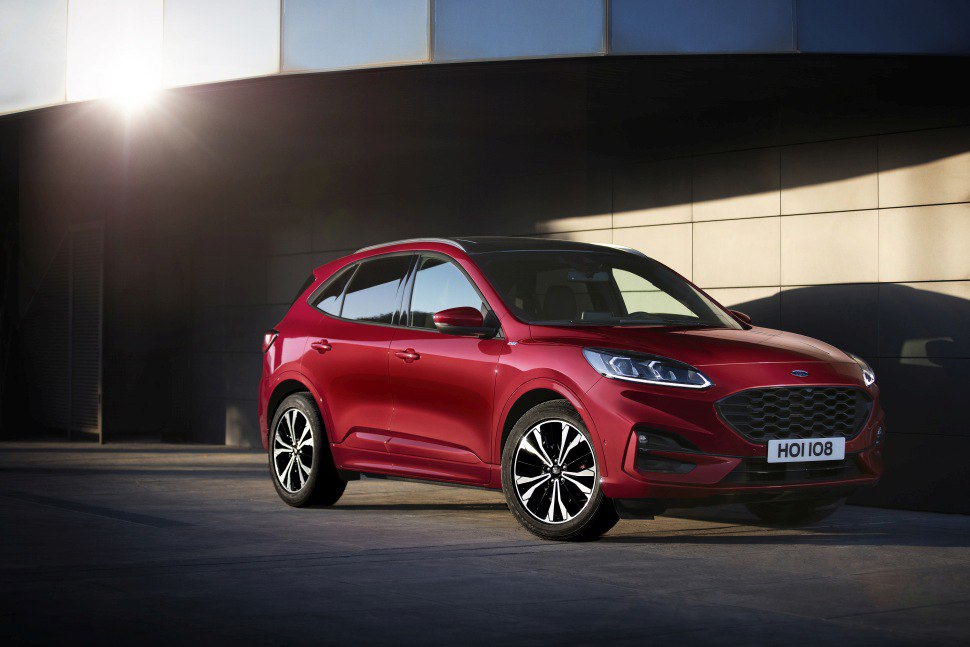Everything you need to know about specifications and performance - Ford Kuga 2019 - 2.5 Duratec (225 Hp) Plug-in Hybrid eCVT

Overview:
What is the engine capacity of a Ford Kuga 2019?
The engine capacity of the Ford Kuga 2019 is 2488.
Ford Kuga 2019 How many horsepower?
The engine power of the Ford Kuga 2019 is 152 Hp.
What is the Ford Kuga 2019 engine?
Ford Kuga 2019 engine is BGDA. (Click to see other cars using the same engine)
How powerful is the electrical system in the Ford Kuga 2019?
The power of the electrical system in the Ford Kuga 2019 is 225 Hp hp.
How much gasoline does a Ford Kuga 2019 consume?
The Ford Kuga 2019 consumes 1.2 liters of gasoline per 100 km
General:
Brand: Ford
Model: Kuga
Generation: III
Modification (Engine): 2.5 Duratec (225 Hp) Plug-in Hybrid eCVT
Start of production: September, 2019
End of production: January, 2024
Powertrain Architecture:Plug-In Hybrid Electric Vehicles (PHEVs)
Body type:Sports Utility Vehicle (SUV)
Seats: 5
Doors: 5
Engine:
Engine systems: Start & Stop System
Power: 152 hp
Power per litre: 61.1 hp/l
Torque: 200 nm
Engine Model/Code:BGDA
Engine displacement: 2488
Number of cylinders: 4
Engine configuration: Inline
Number of valves per cylinder: 4
Fuel injection system: Multi-port manifold injection
Engine aspiration: Naturally aspirated Engine
Valvetrain: DOHC
Engine oil capacity: 5.4 l
Engine layout: Front, Transverse
Cylinder Bore: 89 mm
Piston Stroke: 100 mm
Compression ratio: 13:1
Performance:
Fuel Type: Petrol / electricity
Combined fuel consumption (WLTP): 1.4 l/100 km
Fuel consumption (economy) - combined (NEDC): 1.2 l/100 km
Fuel consumption (economy) - combined: 1.2 l/100 km
Emission standard: Euro 6d-TEMP
Acceleration 0 - 100 km/h: 9.2 sec
Acceleration 0 - 62 mph: 9.2 sec
Maximum speed: 200 km/h
Weight-to-power ratio: 7.9 kg/Hp, 127.2 Hp/tonne
Weight-to-torque ratio: 8.8 kg/Nm, 113.1 Nm/tonne
Max speed (electric): 135 km/h
Acceleration 0 - 60 mph: 8.7 sec
Electric system:
Gross battery capacity: 14.4 kWh
Battery technology: Lithium-ion (Li-Ion)
Battery location: Below the floor
System power: 225 hp
All-electric range: 56 km
Electric motor power: 131 hp
Average Energy consumption: 14.8-15.6 kWh/100 km
Electric motor location: Integrated into the transmission
Average Energy consumption (WLTP): 14.8-15.6 kWh/100 km
All-electric range (WLTP): 56 km
Average Energy consumption (NEDC): 18.7 kWh/100 km
All-electric range (NEDC): 72 km
Space:
Kerb Weight (kg): 1769
Max. weight (kg): 2320
Max. roof load: 75 kg
Max load (kg): 551
Trunk (boot) space - maximum: 1481 l
Trunk (boot) space - minimum: 411 l
Permitted trailer load with brakes (12%): 1200 kg
Fuel tank capacity: 42.7 l
Permitted trailer load without brakes: 750 kg
Permitted towbar download: 100 kg
dimensions:
Length: 4614 mm
Width: 1883 mm
Height: 1675 mm
wheelbase: 2710 mm
Width with mirrors folded: 2000 mm
Width including mirrors: 2178 mm
Front track: 1597 mm
Rear (Back) track: 1588 mm
Ride height (ground clearance): 139-160 mm
Minimum turning circle (turning diameter): 11.38 m
Approach angle: 18.8°
Departure angle: 24.4°
Powertrain, Suspension and Brakes:
Drivetrain Architecture: The Internal combustion Engine (ICE) and electric motor drive the front wheels of the car with the ability to work in full electric or mixed mode.
Drive wheel: Front wheel drive
Number of gears and type of gearbox: automatic transmission eCVT
Front brakes: Ventilated discs, 308-330 mm
Rear brakes: Disc, 302 mm
Assisting systems: ABS (Anti-lock braking system)
Steering type: Steering rack and pinion
Power steering: Electric Steering
Tires size: 225/60 R18; 225/55 R19; 245/45 R20
Wheel rims size: 7.5J x 18; 7.5J x 19; 7.5J x 20; 8.0J x 20
See also

Last generation.
Its production began in 2024 until Now

Other generation.
Its production began in 2008 until 2010

Write a comment